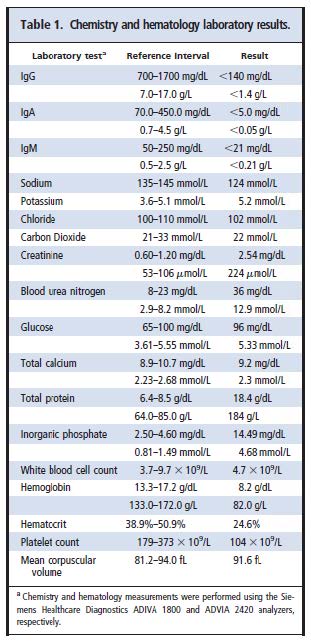Summary
DOI: 10.1373/clinchem.2013.213884
A 53-year-old male patient with an established diagnosis of IgG λ multiple myeloma was seen by a hematologist–oncologist in consultation from an outside hospital. He had previously received 1 cycle of chemotherapy treatment, but he was found to be intermittently noncompliant with his therapy. The patient reported occasional nosebleeds and fatigue. Except for a slightly cachectic appearance, the
Student Discussion
Student Discussion Document (pdf)
A. Gilbert Jelinek* and Lorin M. Bachmann
Department of Pathology, Virginia Commonwealth University, Richmond, VA.
*Address correspondence to this author at: Virginia Commonwealth University, 1101 East Marshall St., Sanger Hall Rm. 4-005, Richmond, VA, 23298. Fax804-628-0290; e-mail [email protected].
Case Description
A 53-year-old male patient with an established diagnosis of IgG λ multiple myeloma was seen by a hematologist–oncologist in consultation from an outside hospital. He had previously received 1 cycle of chemotherapy treatment, but he was found to be intermittently noncompliant with his therapy. The patient reported occasional nosebleeds and fatigue. Except for a slightly cachectic appearance, the physical examination was unremarkable. Laboratory results are shown in Table 1.
Serum protein electrophoresis revealed monoclonal paraproteinemia in high abundance marked by an intense band in the γ region. Immunofixation electrophoresis was not ordered at that time, but it was previously performed at another institution and was positive for IgG monoclonal protein.
The attending pathologist noted the discrepancy between the presence of a monoclonal band by serum protein electrophoresis and the patient’s quantitative immunoglobulin measurements. Several additional suspicious test results were also noted.

Questions to Consider
- What are some expected laboratory results in a patient with multiple myeloma?
- Which of the patient’s laboratory test results are unexpected given his diagnosis of multiple myeloma?
- What types of laboratory errors can occur in patients with multiple myeloma?
Final Publication and Comments
The final published version with discussion and comments from the experts appears
in the November 2014 issue of Clinical Chemistry, approximately 3-4 weeks after the Student Discussion is posted.
Educational Centers
If you are associated with an educational center and would like to receive the cases and
questions 3-4 weeks in advance of publication, please email [email protected].
AACC is pleased to allow free reproduction and distribution of this Clinical Case
Study for personal or classroom discussion use. When photocopying, please make sure
the DOI and copyright notice appear on each copy.
DOI: 10.1373/clinchem.2013.213884
Copyright © 2014 American Association for Clinical Chemistry